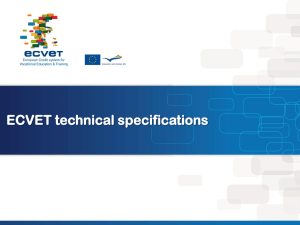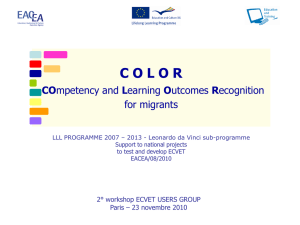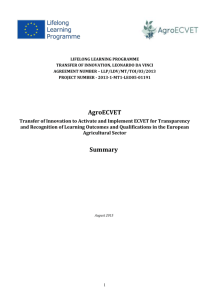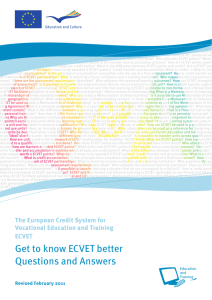Title ECVET unit * Please name the ECVET unit appropriately. See
advertisement
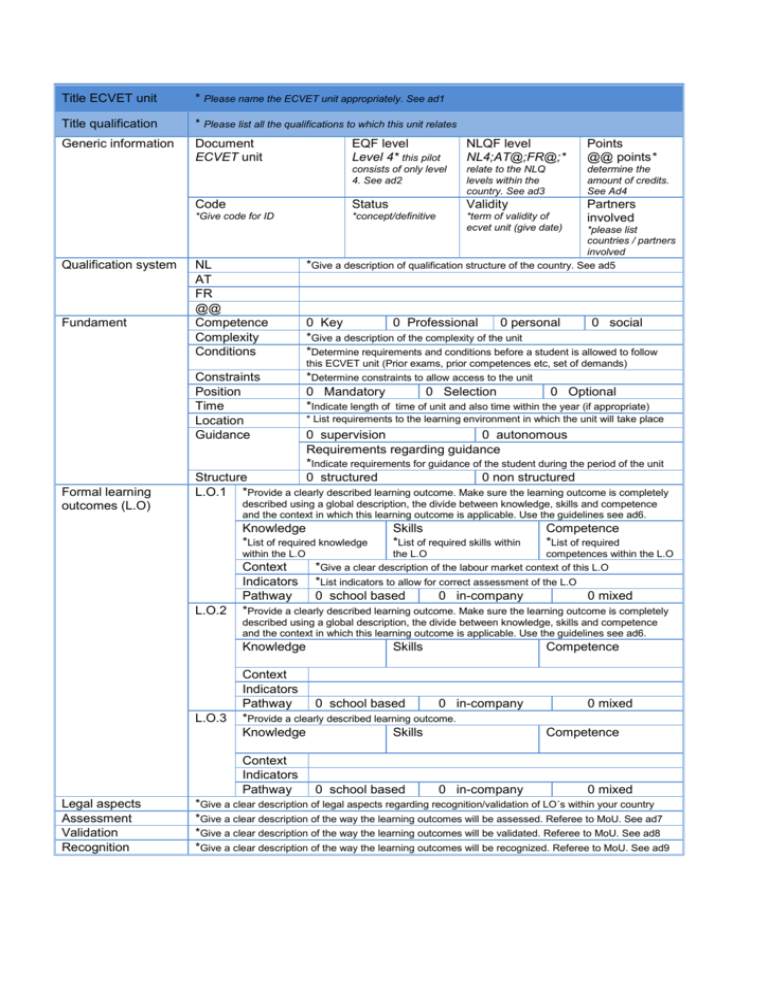
Title ECVET unit * Please name the ECVET unit appropriately. See ad1 Title qualification * Please list all the qualifications to which this unit relates Generic information Document ECVET unit Qualification system Fundament EQF level Level 4* this pilot NLQF level NL4;AT@;FR@;* Points @@ points* consists of only level 4. See ad2 relate to the NLQ levels within the country. See ad3 determine the amount of credits. See Ad4 Code Status Validity *Give code for ID *concept/definitive *term of validity of ecvet unit (give date) Partners involved NL AT FR @@ Competence Complexity Conditions Constraints Position Time Location Guidance Formal learning outcomes (L.O) *please list countries / partners involved *Give a description of qualification structure of the country. See ad5 0 Key 0 Professional 0 personal 0 social *Give a description of the complexity of the unit *Determine requirements and conditions before a student is allowed to follow this ECVET unit (Prior exams, prior competences etc, set of demands) *Determine constraints to allow access to the unit 0 Mandatory 0 Selection 0 Optional *Indicate length of time of unit and also time within the year (if appropriate) * List requirements to the learning environment in which the unit will take place 0 supervision 0 autonomous Requirements regarding guidance *Indicate requirements for guidance of the student during the period of the unit 0 structured 0 non structured Structure L.O.1 *Provide a clearly described learning outcome. Make sure the learning outcome is completely described using a global description, the divide between knowledge, skills and competence and the context in which this learning outcome is applicable. Use the guidelines see ad6. L.O.2 Knowledge *List of required knowledge Skills *List of required skills within Competence *List of required within the L.O the L.O competences within the L.O Context *Give a clear description of the labour market context of this L.O Indicators *List indicators to allow for correct assessment of the L.O Pathway 0 school based 0 in-company 0 mixed *Provide a clearly described learning outcome. Make sure the learning outcome is completely described using a global description, the divide between knowledge, skills and competence and the context in which this learning outcome is applicable. Use the guidelines see ad6. Knowledge L.O.3 Context Indicators Pathway 0 school based 0 in-company *Provide a clearly described learning outcome. Knowledge Skills Context Indicators Pathway Legal aspects Assessment Validation Recognition Skills Competence 0 mixed Competence 0 school based 0 in-company 0 mixed *Give a clear description of legal aspects regarding recognition/validation of LO´s within your country *Give a clear description of the way the learning outcomes will be assessed. Referee to MoU. See ad7 *Give a clear description of the way the learning outcomes will be validated. Referee to MoU. See ad8 *Give a clear description of the way the learning outcomes will be recognized. Referee to MoU. See ad9 Document: Date: Version: Author: Goal: Instructions and additional information on the ECVET format 20130221 0.3 G.Leereveld, Karin Elferink Describe ECVET unit and conditions within the unit to be used as a format and tool for the development of the three ECVET units (management, language and international competences) within the ANGIE 2.0. project. Ad1: Title In case if units concerning learning outcomes are directly related to the exercise of specific activities/tasks or processes on the workplace, the title should be meaningful from the point of view of the labour market. It should also indicate the learning outcomes-based approach of the unit, in other words be encompassing of knowledge, skills and competence (rather than being related to a taught subject) Ad2: EQF Level of ECVET unit Level 4 can be described as follows Knowledge: factual and theoretical knowledge in broad contexts within a field of work or study Skills: a range of cognitive and practical skills required to generate solutions to specific problems in a field of work or study Competence: exercise self-management within the guidelines of work or study contexts that are usually predictable, but are subject to change supervise the routine work of others, taking some responsibility for the evaluation and improvement of work or study activities Ad3: NLQF levels Ad4: Points Allocation of ECVET points to a qualification is based on using a convention according to which 60 points are allocated to the learning outcomes expected to be achieved in a year of formal full time VET. For a given qualification, one formal learning context is taken as a reference and on the basis of 60 ECVET points per year of formal full time VET, the total number of ECVET points is assigned to that qualification. Ad5: Qualification system Give a short description of the way qualifications in the education system of the country is structured. Describe if they are designed conform learning outcomes, in terms of units or not. Are they based on programmes/curricula or are they independent of a programmes/curricula and based on standards? Ad6: Learning outcomes In order to develop transparent descriptions, certain principles for formulating learning outcomes need to be observed. Certain principles for formulating learning outcomes have been identified in different contexts and seem to be useful in order to reach an understanding between partners. Use accurate descriptions and complete sentences which are enriched by examples Elaborate on the different levels of learning outcomes whenever they help to describe a professional profile, for example:. o Use active verbs to describe each learning outcome suggesting overt behaviour Use one verb for each outcome Verbs should describe measurable or observable actions (for example, ‘explain’, ‘identify’, ‘apply’, ‘analyse’, ‘develop’, ‘demonstrate’). It may prove useful to use or develop a taxonomy table with different categories or classifications of verbs (Bloom) Clear, simple wording in unambiguous language Appropriate verbs that reflect both the level and the strand o Formulations, particularly verbs, adjectives and context descriptions, should reflect the level of the specific learning outcomes. For example, it should be specified whether the observable action takes place in a structured or non-structured context or whether it is carried out under supervision or autonomously. Allocate test criteria for each learning outcome to (a), support the learning venues to organise the learning process, and (b), to make the results of the learning process more comprehensible and transparent for companies. o Be aware of the difference between learning objectives and learning outcomes: Learning objectives express the intention of teachers (for example, they are related to the content teachers are planning to present). Learning outcomes are always described from the learners’ viewpoint rather than from the teachers’ viewpoint. The description of learning outcomes should reflect the elements knowledge, skills and competence: o o o Competence: The proven ability to use knowledge, skills and personal, social and/or methodological abilities in work or study situations and in professional and personal development. Described in terms of responsibility and autonomy. It is expressed by its constituent elements (such as type of background, resources used in showing the competence, attitudes, etc.); it is described by using verbs in the infinitive form that clearly identify: the taxonomy of levels of responsibility/autonomy; reference to the resources used; and an indication of the performance depending on the complexity of competence. The description of the competence is based on a single verb. Skills: The ability to apply knowledge and use know-how to complete tasks and solve problems. Knowledge: The outcome of the assimilation of information through learning. Knowledge is the body of facts, principles, theories and practices that are related to a field of work or study. Clustering of learning outcomes There are different criteria according to which learning outcomes can be grouped into units and the choice of which criteria to use depends on the qualifications system. Examples include: • • • • The fact that the learning outcomes relate to the same set of occupational activities/tasks (for example the learning outcomes in a unit entitled “training a horse”); The fact that they are related to the same product or production technique (such as the learning outcomes in a unit entitled “prepare soil”); They can also be grouped according to the stages in the production process or process of performing a service (for example the learning outcomes in a unit called “informing the client about the feed for the animal”); or They can be grouped in a unit because they relate to the same field of knowledge, skills or competence (for example the competence in foreign language can form a separate unit). Ad7: Assessments The agreements of the partners in a mobility action are decisive for the assessment, validation and recognition of learning outcomes against the background of the valid national regulations and practices in the participating states. For this purpose, the partners must agree on criteria for quality assurance in good time Assessment of learning outcomes means methods and processes used to establish the extent to which a learner has in fact attained particular knowledge, skills and competence; • The hosting institution organises the assessment of learning outcomes as specified in the Learning agreement. The assessment can be done by teachers, trainers, employers, etc. depending on the education and training and assessment arrangements and procedures that are used in the host context. • However, it is important that the hosting and home institutions discuss, prior to the mobility, the assessment methods used and the profile of assessors to make sure that these meet the quality assurance requirements expected by the home institution, which will validate the credit (note that this does not mean that the assessment methods and profile of assessors should be the same between the home and the hosting institution). Ad8: Validation Validation of learning outcomes means the process of confirming that certain assessed learning outcomes achieved by a learner correspond to specific outcomes which may be required for a unit or a qualification; The home institution validates the learning outcomes assessed by the hosting institution. In this process the home institution uses a learner’s transcript of record to verify that the learning outcomes defined for the mobility period have indeed been positively assessed in the hosting institution. Concerning the validation of formal, non-formal or informal learning, outside a partnership, it is the competent institution which is empowered to award qualifications or units or to give credit that validates (possibly after organising an assessment) the learning outcomes of a learner. Ad9: Recognition Recognition of learning outcomes means the process of attesting officially achieved learning outcomes through the awarding of units or qualifications The partners are responsible for selecting the procedure for determining and assessing competences. In order to validate and recognize learning outcomes which have been achieved in a different learning context, it is necessary to determine that the learner has actually acquired the competences which have been taught and which are intended. The selection of the method(s) of assessment should be appropriate to the competences to be determined. In the course of the assessment procedure, it is not only possible to assess learning outcomes that are defined in a formal unit of learning outcomes in accordance with the national qualifications system, but also cross-occupational competences which have been acquired during the stay abroad. It is also necessary to determine that the competences were acquired in circumstances that are approved by formal legislation and rules which are mandated by your institutions.


